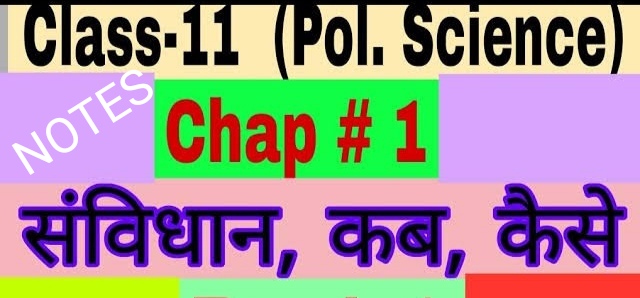Subject: Class 11 Political Science
Book: Indian Constitution at Work
I. Why Do We Need a Constitution?
- Definition of Constitution:
A constitution is a set of fundamental principles or rules according to which a state is governed.
It lays down the structure, powers, and functions of the government.
- Need for a Constitution:
To limit the power of the government.
To protect the rights of citizens.
To define structures of institutions like legislature, executive, and judiciary.
To guide decision-making in democracy.
- Constitution as the Supreme Law:
All laws and actions of the government must conform to the Constitution.
Acts as a reference book in case of disputes or confusion.
II. Functions of a Constitution
- Provides a Set of Rules:
Lays down the basic rules for how people in a society should live together.
- Defines the Nature of Political System:
Whether the country is a republic or monarchy, federal or unitary, presidential or parliamentary.
- Limits the Power of the Government:
By creating a system of checks and balances.
Separation of powers among legislature, executive, and judiciary.
- Establishes Rights of Citizens:
Guarantees Fundamental Rights.
Protects minorities and weaker sections.
- Expresses National Identity and Goals:
Preamble reflects the values of justice, liberty, equality, and fraternity.
III. How Did India Adopt Its Constitution?
- Historical Background:
Colonial rule under Britishers.
Need for self-rule and a democratic system.
- Formation of Constituent Assembly:
Formed in December 1946.
Members were elected indirectly by the Provincial Legislative Assemblies.
Represented all regions, religions, castes, and communities.
- Chairman and Committees:
Dr. Rajendra Prasad – President of the Assembly.
Dr. B.R. Ambedkar – Chairman of Drafting Committee.
- Drafting of the Constitution:
Took 2 years, 11 months, and 18 days.
Adopted on 26 November 1949.
Came into force on 26 January 1950 (celebrated as Republic Day).
IV. The Making of the Indian Constitution
- Sources of the Constitution:
Borrowed from different countries:
Parliamentary system – Britain
Fundamental Rights – USA
Directive Principles – Ireland
Emergency provisions – Germany
Independent judiciary – USA
- Debate and Deliberation:
Every clause was discussed in detail.
Over 2000 amendments made before final approval.
Constitution is not just a copy but adapted to Indian needs.
V. Features of the Indian Constitution
- Lengthiest Written Constitution:
More than 448 articles and 12 schedules.
Includes detailed provisions.
- Blend of Rigidity and Flexibility:
Some parts are easy to amend (like laws), some need special procedure.
- Federal Structure with Unitary Bias:
Power divided between centre and states.
In emergencies, the centre becomes more powerful.
- Parliamentary System:
Based on the Westminster model (UK).
President is the nominal head; Prime Minister is the real executive.
- Secularism:
No official religion; all religions treated equally.
- Democracy and Republic:
People elect their leaders.
Head of state (President) is elected and not hereditary.
- Independent Judiciary:
Supreme Court ensures justice and protects Constitution.
VI. Philosophy of the Constitution – The Preamble
- Components of the Preamble:
We, the People of India – power lies with the people.
Sovereign – India is free to make its own laws.
Socialist – Social and economic equality.
Secular – Equal respect for all religions.
Democratic – People have the right to choose their representatives.
Republic – No hereditary ruler; elected head of state.
Justice, Liberty, Equality, Fraternity – Goals of the Constitution.
VII. Constitutional Amendments
- Why is Amendment Necessary?
Society and needs change over time.
Constitution must evolve.
- Types of Amendments in India:
Simple majority – Ordinary laws.
Special majority – Major changes (e.g., Fundamental Rights).
Special + State ratification – Changes affecting states (e.g., federal structure).
- Example – 42nd Amendment (1976):
Added words “Socialist”, “Secular”, and “Integrity” to the Preamble.
VIII. Significance of the Indian Constitution
Promotes democracy and equality.
Provides a blueprint for governance.
Ensures peaceful transition of power.
Protects minority rights and social justice.
Balances liberty with law and order.
Important Terms:
TermMeaningConstitutionSupreme law of the landPreambleIntroduction to the ConstitutionSovereignFree from external controlSocialistEconomic equality for allSecularEqual treatment of all religionsRepublicHead of state is electedDemocracyRule by the peopleAmendmentFormal change in Constitution
Summary:
The Constitution of India is not just a legal document, but a living document that reflects the aspirations, ideals, and values of the people of India. It ensures justice, equality, and liberty, and provides a strong foundation for democracy.







